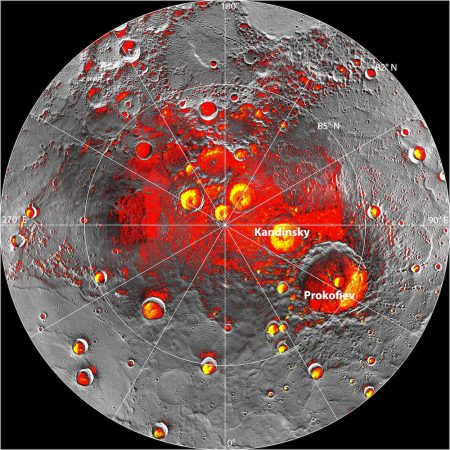Ice on Mercury
MESSENGER spacecraft provides evidence for frozen water on planet closest to sun

NASA/Johns Hopkins University Applied Physics Laboratory/Carnegie Institution of Washington/National Astronomy and Ionosphere Center, Arecibo Observatory
Bright spots on Mercury have long tantalized astronomers. The shiny patches have appeared to be swatches of ice. In November, that old idea received new support from a spacecraft that’s been watching the tiny planet. Fresh data from the satellite offer the best evidence yet that frozen water lies exposed in dark craters near the north and south poles of the sun’s nearest neighbor. Even more ice might lie buried out of sight.
Water is a necessary ingredient for life as we know it. That’s why scientists get excited when they find it in any form. Unfortunately, there’s little chance of life on Mercury. Its proximity to the sun and thin atmosphere create punishing swings in temperature. During the day, the surface can soar to 427 degrees Celsius (801 Fahrenheit). At night, ground temperatures can plummet to far, far below zero. Still, understanding how water arrived on the planet might help researchers learn more about how life got its start on Earth.
“Studying this stuff elsewhere in the solar system is really relevant for the origin of life,” David Paige told Science News. He’s a planetary scientist at the University of California, Los Angeles. He also worked on the new study.
The new evidence for ice on Mercury comes from a NASA spacecraft. It has been orbiting the planet since March 2011. The satellite’s name, MESSENGER, stands for MErcury Surface, Space ENvironment, GEochemistry and Ranging.
Scientists first detected the bright spots near Mercury’s poles in the 1990s. At the time, the data came from Earth-based instruments. To make new studies of the spots near the planet’s north pole, scientists used an instrument aboard MESSENGER called a laser altimeter (Al-TIM-eh-ter). This machine fires a laser beam at the planet’s surface. Then it measures how much of the light reflects back — and how long it takes. These measurements can be used to map out peaks, valleys and craters of the planet’s surface. They also reveal the brightest spots on the planet. Ice appears especially reflective and bright to the instrument.
Paige and his collaborators designed computer models to combine data about Mercury’s north pole that gets beamed back from MESSENGER along with data from Earth-based telescopes. A computer model is a program that brings together existing data about something to build a larger picture — like predicting different possible solutions to a large puzzle for which you only have only a few pieces. Scientists can use computer models to run calculations, test ideas or make predictions. In this case, the computer model of Mercury lined up exactly with observations from MESSENGER.
“We actually see bright ice every place we expect to see it,” Paige told Science News.
MESSENGER’s measurements show that in shadowy craters near Mercury’s north pole — the same region where bright spots were detected — the temperature drops below -173 degrees Celsius (-279 Fahrenheit). Since Mercury tilts very little as it orbits the sun, the sun’s rays never reach inside craters near the planet’s poles. So any ice there remains in a deep freeze.
Measurements of darker areas near the pole pointed to the possibility of more ice, though buried. Data collected by another instrument aboard MESSENGER, called a neutron spectrometer, provided additional evidence for the buried ice, which is blanketed by a mysterious dark material. MESSENGER’s photos show that the south pole has similar features — and probably also harbors ice.
Scientists say that Mercury’s ice probably came from afar, brought by asteroids and comets that slammed into the planet. These impacts left behind giant craters — and patches of ice. Says Paige: “It’s like you’ve got bunch of people with shovels, reworking the surface.”
Power Words
asteroid A small, rocky body orbiting the sun.
comet A celestial object consisting of a nucleus of ice and dust. When a comet passes near the sun, gas and dust boil off the comet’s surface to create its “tail.”
altimeter An instrument used to determine altitude, or height above a surface.
laser A device that generates an intense beam of single-colored light (or other electromagnetic radiation) by stimulated emission of photons from excited atoms or molecules.
computer model A computer or computer program that uses existing data to make predictions about complicated systems.







